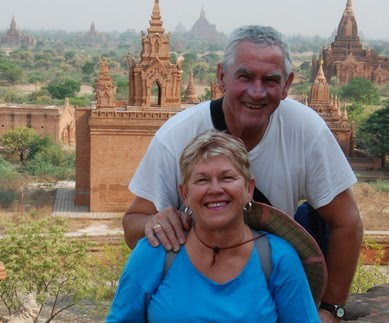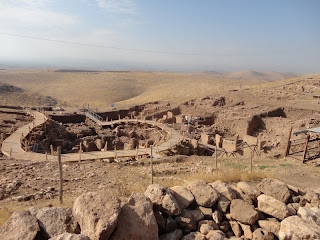Today finds us in Tabriz Northern Iran after riding a bus from the border. (There were some really difficult blokes on the bus being childish and it made our journey very unpleasant).
 |
| Short distance Meredes Benz buses. |
 |
| Hotel Moravid Tabriz |
 |
| On the way to the markets. Chador clad ladies. |
Today Tabriz is an industrial city. The road still leads to Turkey and the markets of Europe. Embargos are in place. (I counted at least 350 articulated lorries stacked up on both sides of the border). But they all get through somehow.
The industry around Tabriz consists of Automotive, Cement Plants and Industrial Factories turning out all sorts of things. The city is pleasant with wide one-way streets. The traffic is very very fast when it is not in a log jam.
The buildings are three story limit. I guess because of the earth shaking.
In the centre of Tabriz is the famous World Heritage listed Tabriz Bazaar. It is the largest covered bazaar in the world and it is the longest. Aleppo Bazaar in Syria is larger by size m2. (Pam, Kellie and I visited in 1974). These places make Westfield look pale, but it is interesting the layout in Westfield centers follow the same, central walkways and specialized areas. Two levels is some areas, housing smaller specialized tenants and showrooms.
But I am getting ahead of myself again as always.
We wanted to visit the carpet markets within the bazaar. Citt and I have an interest in carpets and we thought you might like to take a look with us? But first a bit about carpets before we go in.
 |
| A very different carpet (Image Citt Williams) |
The Tabriz Bazaar was and still is the most important market for the sale and distribution of carpets. (Tehran we were told was bigger but did not specialize in quality rare carpets).
Where do they come from?
Each carpet has a story!
The story is in the pattern. It can be the story of the family, the village, the tribe. Some patterns stretch back centuries. (The families are very bitter as Chinese factories are copying the patterns and manufacturing carpet copies in large factories without permission.) The dealers can tell you where the carpet came from and just about who made it. The number of knots, the lay of the carpet, the fibre all make for the true value of a carpet. A carpet can be made out of wool, camel hair, cotton, silk or a mixture. The dyes used in the carpets are at best natural vegetable and plant dyes. Some rugs can take up to 5 years to complete.
The family manufacturing a carpet is by no means guaranteed a good price for the carpets as in this area borders tend to change without warning. There are stories of false walls in houses to hide the rugs in time of trouble. A rug maker is highly skilled and take on apprentices in the art. The rug makers specialize in the making of, or repair and remake of, damaged rugs. The value of a carpet is complicated taking into account the number of knots, the color, the size, the materials used and the quality of the workmanship, last but not least the rarity of the pattern.
 |
| Mozaffarieh alley (fine carpets) Tabriz Bazaar |
 |
| Chaikana having lunch. Note the Hooka pipes |
Just click the picture and the near the top of the picture where it says information clik the full screen and you will have information on the image.
Enjoy.
After the carpets we decided we had better get going and explore some of the outlying region instead of drooling over these gorgeous works of art.
So we hired a taxi and off we went to Kandovan a village of rock houses, no tourists and beautiful weather.
 |
| The stone houses of Kandovan 1300 AD Iran. |
This is my journal date 22/10/11































